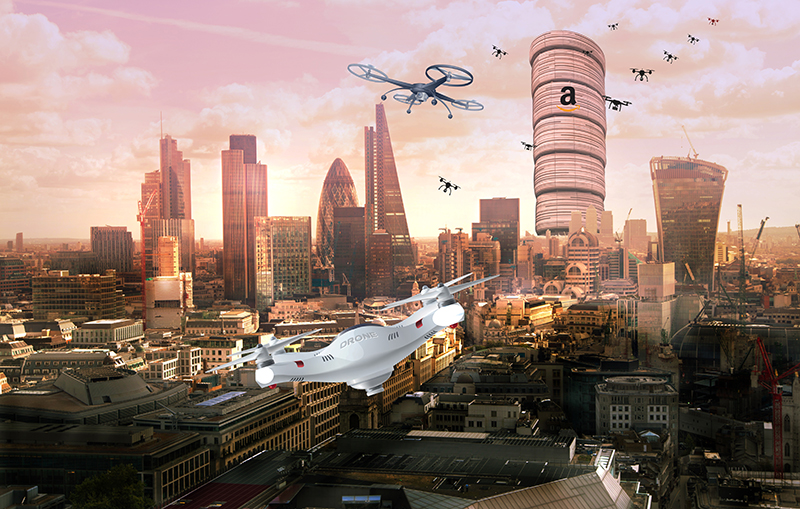By Tom Kaiser
After patent drawings illustrating beehive-like drone skyscrapers leaked, Amazon appears closer than ever to building the distribution infrastructure necessary to allow delivery drones to crisscross the skies above major cities.
A mere week after the Seattle-based online giant bought Whole Foods for a cool $13.7 billion, its patent drawings were published detailing tall, multi-level fulfillment centers designed to act as a hub for unmanned aerial vehicles. According to the patent papers, they will include multiple levels with “one or more landing locations” and drone landing platforms to accommodate delivery of retail goods in record time.
With drone “apertures located in the exterior shell at different altitudes,” the so-called drone towers bear an uncanny resemblance to a massive, futuristic beehive that evokes flashes of Bee Movie where everybody gets a hive-centric job to support the communal mission: in this case, global domination of on-demand retail delivery.
Reading deeper into the patent filing, the multi-level distribution centers will be vertically oriented to allow delivery drones to fly in and out without causing an aerial traffic jam. Under the exterior are robotic lift mechanisms to provide “upward air movement” through the building, as well as “impact dampeners” that could reduce potential damage to drones that may fall down while on the job. On-site service bays will maintain, repair and recharge the drones, allowing deliveries to continue without interruption.
While Amazon didn’t respond to our requests for comment about the hypothetical towers, there is much to be learned perusing the patents, as well as looking at the company’s recent grocery experiments and other strategic moves, including the Whole Foods purchase.
Bill Bishop of Brick Meets Click, a grocery-and-retail consultancy, said the drone delivery towers allow Amazon to add distribution capacity in the heart of city centers—where its demand is highest—without having to build a horizontally sprawling campus that’s the M.O. of nearly ever other distribution center to date.
“These beehive-looking things are robotic selection systems that represent the state of the art in terms of speed and efficiency,” Bishop said.
As someone who makes a living by analyzing public moves and private speculation within the industry, Bishop said that Amazon announced its purchase of Whole Foods at the same time that hard-charging German grocer Lidl announced ambitious U.S. expansion plans—which he argued was not a coincidence.
“Part of what’s happening here is that there’s a mind game being played by Amazon,” he said. “In addition to being very good at a number of things, Amazon is also very good at holding attention and…not letting anybody else cast a shadow that would raise a question about their continuing emergence as a leader in distribution.”
Skepticism aside, Bishop added that these patents could point the way to imminent tower construction, but also be another example of Amazon hedging its bets and experimenting before any cranes hit the skyline in a metro near you.
With Amazon’s Fresh grocery division a decade in the making, Bishop said the towers could never see the light of day, but countered that such a distribution system does serve the company’s wider goals of conquering all aspects of a national distribution network.
Detailed descriptions of the patent filing gets into extreme detail, including the ideal location for such fulfillment centers (downtown districts), as well as the means for delivering freight to the centers, accommodation for more typical, truck- and rail-based freight transfers, and using autonomous vehicles to perform many of the functions within the building.
In addition, current FAA guidelines require a human set of eyes on unmanned drones, meaning that Amazon’s drone towers would also serve as urbanized air-traffic control towers. As proposed, the high-tech fulfillment centers would include places for consumers to drive up and pick up their own items, presumably saving on shipping costs or eliminating waiting altogether.
No word on whether any other major retailers have plans for drone towers, but suddenly it seems likely we could have busier skies in urban centers, with the prospect of new high-rises in cities large enough to justify the expense and infrastructure required to make large-scale drone deliveries a reality. How about that for some new-age urban renewal?




